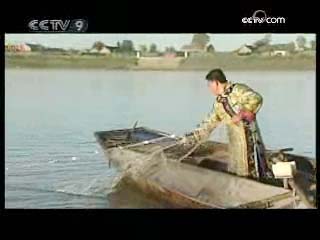------Program code: DO-080822-01317 (what's this?)
Source: CCTV.com
08-22-2008 08:52
 |
Early every morning, when most people are still asleep, a group of hard-working people in easternmost China are already up and welcoming the new day. They are from the ethnic group living in the East who are the first to welcome the sun each day – the Hoche Nationality.
“Hoche” is a Manchu word meaning “people of the East”. They are the only ethnic group in Northern China to live on fishing. The Hoche people today live mainly in Raohe, Fuyuan and Tongjiang Counties in Heilongjiang Province, and Jiejinkou Town in Tongjiang, Sipai Town in Raohe County, and Aoqi Village near Jiamusi City. The Hoche people have a long history and are closely related to other ancient nationalities of China’s northeast, such as the “Sushen” and “Nvzhen”. Hoche people have been living on the Sanjiang Plain of northeast China since the Ming and Qing Dynasties. Historically, they have also been called the “Heijin” ”Heizhen” ”Hezhen” and “Qileng”.
 |
After the People’s Republic of China was founded, the nationality got its present name “Hoche”. That was in 1956. According to the fourth national census in 1990, the Hoche ethnic group had a population of fewer than 4,200, making it one of the smallest nationalities in China.
Sipai Town in Raohe County is a major population centre of the Hoche people. It lies on the Chinese side of the river border with Russia. The famous “Boat Song on the Wusuli River” is adapted from a popular folk song in the area, “My Lover Returns from Hunting”.
The Hoche people reside by the big river and live by fishing. They have many ways of eating fish, either raw or cooked. The raw fish can be either sliced or flaked, while the cooked fish includes baked “??”. Today, Hoche people still prefer these traditional ways of eating fish.
Whatever the season, Hoche people are always out hauling their fishing nets. Whatever the direction of the river’s flow, they can always set their hooks. They make a variety of boats and use them according to the character of the water. Birch boats are the most common and the easiest to build. A birch boat built in the traditional way is kept in Sipai Village, Raohe County.
The birch boat is exhibited in the museum. But it is still capable of putting out on the big river.
The boat was made by Fu Zhanxiang, a famous Hoche craftsman who grew up by the river.
The Wusuli is one of the most famous rivers in northeast China. It has fast flowing water and a strong current. But can such small boats really go out fishing on such a big river?
Historically, the Hoche people have used various forms of boats for fishing, including the “saddle support” and “??”. But birch boats are easy to build and the materials are readily available. So they can be built and then abandoned later.
Birch boats are usually several meters long. Sometimes, a single piece of birch bark doesn’t suffice. So several pieces have to be put together to make a waterproof hull bottom.
The ancestors of today’s Hoche people used birch boats for thousands of years. The skills of making them have been passed down from one generation to the next.
Like a true mother river, the Wusuli provides abundant food for the Hoche people, as well as the materials they need in production and life.
The Wusuli is a major tributary of the Heilongjiang River. It rises from Sichote-Alin and Khanka Lake, winds its way into China, and finally empties into the Heilongjiang River. The course of the river extends from Wanda Mountain in China to Sichote-Alin in Russia. For most of its journey, the river flows across plains and wetlands. The Wusuli, together with the Heilongjiang and Songhua Rivers, forms the beautiful Three-river Plain where the Hoche people live.
In Raohe County there is the ancient Xiaonanshan Cultural Site, where pottery and jade-ware from the Neolithic Period more than 7,000 years ago, have been unearthed. These cultural relics exhibit the features of a fishing civilization. The discovery of the relics extends the history of human activity in the region back by over 1,000 years. The discoveries suggest that fishing culture, like the agrarian culture on the central plains of China and the animal-breeding culture of northwest China, was a unique source of the development of human civilization.
The Hoche people who live by the Wusuli River today, maintain many of their ancient traditions.
But they are no longer permitted to hunt, because of the wildlife protection policy. But remnants of their ancient fishing culture are still evident in the Hoche people’s life. Although fish stocks in the Wusuli have declined sharply as a result of over-fishing, the Hoche affinity with fishing remains strong.
The Hoche people could not live without birch trees. Wherever there are Hoche people, there are birch trees. Dadingzi Mountain, mentioned in the “Boat Song on the Wusuli River” is where the Hoche people used to find their birch bark.
Birch trees are spread across wide areas of the Greater and Lesser Khingan Mountains. Chinese minorities such as the Olunchun and Hoche have traditionally used birch bark to make their tools for production and living. But the bark can only be collected between spring and summer. According to Hoche tradition, everything has its spirit, and they refuse to allow birch to die after having its bark removed.
